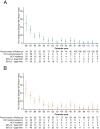Declining incidence of hepatitis C virus infection among people who inject drugs in a Canadian setting, 1996-2012
- PMID: 24897109
- PMCID: PMC4045728
- DOI: 10.1371/journal.pone.0097726
Declining incidence of hepatitis C virus infection among people who inject drugs in a Canadian setting, 1996-2012
Abstract
Background: People who inject drugs (PWID) are at high risk of hepatitis C virus (HCV) infection. Trends in HCV incidence and associated risk factors among PWID recruited between 1996 and 2012 in Vancouver, Canada were evaluated.
Methods: Data were derived from a long-term cohort of PWID in Vancouver. Trends in HCV incidence were evaluated. Factors associated with time to HCV infection were assessed using Cox proportional hazards regression.
Results: Among 2,589, 82% (n = 2,121) were HCV antibody-positive at enrollment. Among 364 HCV antibody-negative participants with recent (last 30 days) injecting at enrollment, 126 HCV seroconversions were observed [Overall HCV incidence density: 8.6 cases/100 person-years (py); 95% confidence interval (95% CI): 7.2, 10.1; HCV incidence density among those with injecting during follow-up: 11.5 cases/100 py; 95% CI 9.7, 13.6]. The overall HCV incidence density declined significantly from 25.0/100 py (95% CI: 20.2, 30.3) in 1996-99, as compared to 6.0/100 py (95% CI: 4.1, 8.5) in 2000-2005, and 3.1/100 py (95% CI: 2.0, 4.8) in 2006-2012. Among those with injecting during follow-up, the overall HCV incidence density declined significantly from 27.9/100 py (95% CI: 22.6, 33.6) in 1996-99, as compared to 7.5/100 py (95% CI: 5.1, 10.6) in 2000-2005, and 4.9/100 py (95% CI: 3.1, 7.4) in 2006-2012. Unstable housing, HIV infection, and injecting of cocaine, heroin and methamphetamine were independently associated with HCV seroconversion.
Conclusions: HCV incidence has dramatically declined among PWID in this setting. However, improved public health strategies to prevent and treat HCV are urgently required to reduce HCV-associated morbidity and mortality.
Conflict of interest statement
Figures






Similar articles
-
Sexual behaviour as a risk factor for hepatitis C virus infection among people who inject drugs in Montreal, Canada.J Viral Hepat. 2019 Dec;26(12):1413-1422. doi: 10.1111/jvh.13194. Epub 2019 Sep 11. J Viral Hepat. 2019. PMID: 31433888
-
Incidence of primary hepatitis C virus infection among people who inject drugs in Australia pre- and post-unrestricted availability of direct acting antiviral therapies.Addiction. 2023 May;118(5):901-911. doi: 10.1111/add.16113. Epub 2022 Dec 29. Addiction. 2023. PMID: 36524842
-
Short and sporadic injecting cessation episodes as predictors of incident hepatitis C virus infection: findings from a cohort study of people who inject drugs in Montréal, Canada.Addiction. 2019 Aug;114(8):1495-1503. doi: 10.1111/add.14632. Epub 2019 May 28. Addiction. 2019. PMID: 30957310
-
Incidence of HIV and hepatitis C virus among people who inject drugs, and associations with age and sex or gender: a global systematic review and meta-analysis.Lancet Gastroenterol Hepatol. 2023 Jun;8(6):533-552. doi: 10.1016/S2468-1253(23)00018-3. Epub 2023 Mar 27. Lancet Gastroenterol Hepatol. 2023. PMID: 36996853 Free PMC article.
-
Homelessness, unstable housing, and risk of HIV and hepatitis C virus acquisition among people who inject drugs: a systematic review and meta-analysis.Lancet Public Health. 2021 May;6(5):e309-e323. doi: 10.1016/S2468-2667(21)00013-X. Epub 2021 Mar 26. Lancet Public Health. 2021. PMID: 33780656 Free PMC article.
Cited by
-
Clinical and functional characteristics of young adults living in single room occupancy housing: preliminary findings from a 10-year longitudinal study.Can J Public Health. 2018 Apr;109(2):204-214. doi: 10.17269/s41997-018-0087-9. Epub 2018 May 31. Can J Public Health. 2018. PMID: 29981045 Free PMC article.
-
Transmission of hepatitis C virus infection among younger and older people who inject drugs in Vancouver, Canada.J Hepatol. 2016 Jun;64(6):1247-55. doi: 10.1016/j.jhep.2016.02.031. Epub 2016 Feb 26. J Hepatol. 2016. PMID: 26924451 Free PMC article.
-
Dual sexual and drug-related predictors of hepatitis C incidence among sex workers in a Canadian setting: gaps and opportunities for scale-up of hepatitis C virus prevention, treatment, and care.Int J Infect Dis. 2017 Feb;55:31-37. doi: 10.1016/j.ijid.2016.12.019. Epub 2016 Dec 24. Int J Infect Dis. 2017. PMID: 28027990 Free PMC article.
-
Needle syringe programmes and opioid substitution therapy for preventing hepatitis C transmission in people who inject drugs.Cochrane Database Syst Rev. 2017 Sep 18;9(9):CD012021. doi: 10.1002/14651858.CD012021.pub2. Cochrane Database Syst Rev. 2017. PMID: 28922449 Free PMC article.
-
The hepatitis C epidemic in Canada: An overview of recent trends in surveillance, injection drug use, harm reduction and treatment.Can Commun Dis Rep. 2021 Dec 9;47(12):561-570. doi: 10.14745/ccdr.v47i12a01. eCollection 2021 Dec 9. Can Commun Dis Rep. 2021. PMID: 35692566 Free PMC article.
References
-
- Maher L, Jalaludin B, Chant KG, Jayasuriya R, Sladden T, et al. (2006) Incidence and risk factors for hepatitis C seroconversion in injecting drug users in Australia. Addiction 101: 1499–1508. - PubMed
Publication types
MeSH terms
Grants and funding
LinkOut - more resources
Full Text Sources
Other Literature Sources
Medical

